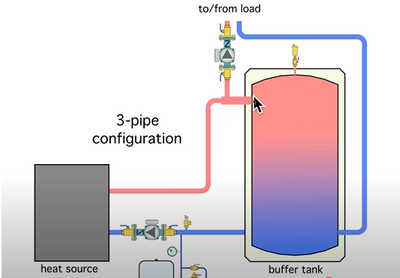Avoid the Heat Pump Villain: Why Low-Loss Headers and Buffers Can Sabotage Your Heat Pump's Efficiency
In light of the recent buffer tank/warranty comments in this topic, I’ve written this piece below. It’s a 10 minute read, but I think it warrants a dedicated video/podcast, because there’s a lot of ambiguity and grey areas here that need clarification.
Get a copy of The Ultimate Guide to Heat Pumps
Subscribe and follow our YouTube channel!
@potatoman As no one seems to be obliging, I attach a diagram. The idea is that only bypass flow goes through the tank when necessary so it is undisturbed by main flow. Connection to tank must be closely coupled.
Private individual. No affiliation with commercial "Heat Geeks" of same coincidental name.
@heatgeek is it that this design satisfies the manufacturers? its still (although balance by bypass) a double hydronic volumiser/buffer with 2 pumps
AAC Group Ltd covering the Kent Area for design, supply and installation of ASHP systems, service and maintenance, diagnostics and repairs.
Professional installer. Book a one-to-one consultation for pre- and post-installation advice, troubleshooting and system optimisation.
@ashp-bobba I am afraid that you are talking to the wrong person about manufacturers preferences. However, as far as I can see, it functions the same as a 4 port buffer except that flow doesn't go through the top of the tank causing mixing, therefore I would have thought that it is a perfectly acceptable alternative to a 4-port.
Private individual. No affiliation with commercial "Heat Geeks" of same coincidental name.
@heatgeek Oh agreed, its a slightly better and slightly less resistive solution, perhaps even the middle ground of no buffer V buffer.
AAC Group Ltd covering the Kent Area for design, supply and installation of ASHP systems, service and maintenance, diagnostics and repairs.
Professional installer. Book a one-to-one consultation for pre- and post-installation advice, troubleshooting and system optimisation.
@potatoman hi, the scheme detailed is 2 pumps, one for the ASHP (primary) and 1 for the secondary circuits.
AAC Group Ltd covering the Kent Area for design, supply and installation of ASHP systems, service and maintenance, diagnostics and repairs.
Professional installer. Book a one-to-one consultation for pre- and post-installation advice, troubleshooting and system optimisation.
@potatoman No, the installation is exactly the same as a 4 port buffer with primary and secondary pumps except that the output flow bypasses the top of tank so as not to disturb the stratification of the tank. This removes some of the inefficiency problems associated with 4 port buffer tanks, like output temperature being reduced by mixing.
Private individual. No affiliation with commercial "Heat Geeks" of same coincidental name.
Note a key point here though. The primary pump is connected in the return pipe while the secondary pump is connected in the flow pipe after the buffer tank to provide good hydronic separation between the primary and secondary pumps.
Private individual. No affiliation with commercial "Heat Geeks" of same coincidental name.
Only the difference in flow between the heat pump and the emitters passes through the tank. This lower flow helps to preserve the stratification of the tank so that dilution of temperature to the emitters is minimised.
Private individual. No affiliation with commercial "Heat Geeks" of same coincidental name.
Apologies. Poor choice of words. Delete "dilution of temperature to emitters is minimised".
Private individual. No affiliation with commercial "Heat Geeks" of same coincidental name.
Posted by: @heatgeekNote a key point here though. The primary pump is connected in the return pipe while the secondary pump is connected in the flow pipe after the buffer tank to provide good hydronic separation between the primary and secondary pumps.
That all sounds very believable. Presumably mixing of return water with flow water to the emitters (and thus a reduction of ft to emitters) will however still occur if the primary pump throughput is less than the secondary, so the requirement to set up properly remains albeit that it is less sensitive than a 4 port.
4kW peak of solar PV since 2011; EV and a 1930s house which has been partially renovated to improve its efficiency. 7kW Vaillant heat pump.
-
British Gas Heat Pump Installation Complaint
1 month ago
-
Heating Turned Off but Radiators Still Warm
2 months ago
-
Samsung Heat pump with Yonos Pico circulating pump running all the time
2 months ago
-
Samsung 5kW R32 Monobloc Gen 6 ASHP
3 months ago
-
Ideal Logic 10kW Heat Pump Pipes Noisy and Very Expensive to Run
10 months ago
Currently viewing this topic 3 guests.
- 26 Forums
- 2,342 Topics
- 53 K Posts
- 195 Online
- 6,000 Members
Join Us!
Worth Watching
Latest Posts
-

RE: Are We Sleepwalking Into Another Race to the Bottom?
…otherwise known as “hive got news for you”. And don’...
By Majordennisbloodnok , 2 hours ago
-
RE: Configuring third party dongle for Ecodan local control
Logically, I'll fall into that category so the natural ...
By Sheriff Fatman , 3 hours ago
-

RE: Controlling Daikin Altherma via P1P2 and Home Assistant
I haven’t got a Daikin but I have been having some fun ...
By Majordennisbloodnok , 3 hours ago
-

RE: Setback savings - fact or fiction?
@robs — thanks again for your detailed comments. Some r...
By cathodeRay , 5 hours ago
-
RE: Free Ecoheat Heat Pump Install
I don't mind thread drift, it's how conversation natura...
By Deltona , 7 hours ago
-

RE: A Smarter Smart Controller from Homely?
@papahuhu I hope you get a swift resolution. Regards, T...
By Toodles , 9 hours ago
-

RE: Poll for Time of Use, tariffs, technology
That’s fine by me too Major, I feel it is a sad reflect...
By Toodles , 10 hours ago
-

Bingo. Sometimes a judiciously placed size 10 bovver bo...
By Majordennisbloodnok , 11 hours ago
-
RE: Mitsubishi Ecodan 11.2kW heat pump with low COP
@ciocoiu-alexandru I can't provide the same level of di...
By Sheriff Fatman , 11 hours ago
-
RE: Octopus Cosy Heat Pump Owners & Discussion Thread
Recently had my follow up with octopus for the vibratio...
By swwils , 12 hours ago
-

The three technical issues I'm considering are: BMS...
By Transparent , 13 hours ago
-
RE: LiFePO4 lithium battery fires and explosions
@transparent Your post may fit better in th...
By Batpred , 13 hours ago
-

RE: British Gas vs Octopus Energy vs Heat Geek vs EDF vs Aira vs OVO vs EON.Next vs Boxt
@jamespawhite, if you could be bothered, you could also...
By Mars , 15 hours ago
-
RE: Commencing on an ASHP Installation Process
I've got a bit of time to draft something today, so the...
By Sheriff Fatman , 1 day ago
-
RE: Help with heat pump sizing
@amin I dont think materially relative to t...
By JamesPa , 1 day ago
-

@majordennisbloodnok I have decided to take the plunge....
By TechnoGeek , 1 day ago
-
RE: Different dT on each radiator?
I cant sorry. Its based on some calculations I did fro...
By JamesPa , 2 days ago
-
RE: Help me keep the faith with my air source heat pump installation
@simonf thats interesting as I’ve noticed my flow and r...
By AdamK , 3 days ago






